The People Power Movement was a key moment in Philippine history. It marked the shift from Ferdinand Marcos’s rule to a democratic government. This movement greatly influenced Philippine Democracy and left a lasting mark on the country.
In 1985, a petition for Cory Aquino to run against President Marcos got over 1 million signatures. This showed the public’s strong wish for change.
The movement’s importance is huge. It ended Marcos’s 20-year rule and opened a new chapter for Philippine Democracy. The People Power Movement showed the power of coming together for freedom and democracy.
Ferdinand Marcos’s regime was known for corruption, human rights abuses, and economic troubles. These issues led to his downfall.
Key Takeaways
- The People Power Movement was a series of protests that led to the ousting of Ferdinand Marcos and the restoration of democracy in the Philippines.
- The movement was sparked by the assassination of Benigno Aquino Jr. and gained momentum through the participation of millions of Filipinos.
- The People Power Movement had a profound impact on Philippine Democracy, paving the way for a new era of freedom and democratic governance.
- Ferdinand Marcos’s regime was marked by corruption, human rights abuses, and economic crisis, which ultimately led to his downfall.
- The movement’s success inspired similar nonviolent movements in various countries, particularly in former Soviet bloc nations.
- The legacy of the People Power Movement continues to shape Philippine politics and society today.
The Political Climate of the Philippines in the Early 1980s
The Philippines was under Martial Law from 1972 to 1981. During this time, President Ferdinand Marcos tightened his grip on power. He also silenced any opposition.
This era was also hit by an Economic Crisis and social unrest. These issues fueled the Opposition Movement. Martial Law led to the arrest of tens of thousands. Many were tortured, killed, or disappeared.
The Economic Crisis worsened the country’s poverty and inequality. The Opposition Movement grew stronger. People demanded an end to Marcos’ rule.
The assassination of Senator Benigno Aquino Jr. in 1983 was a turning point. It rallied more people against Marcos.
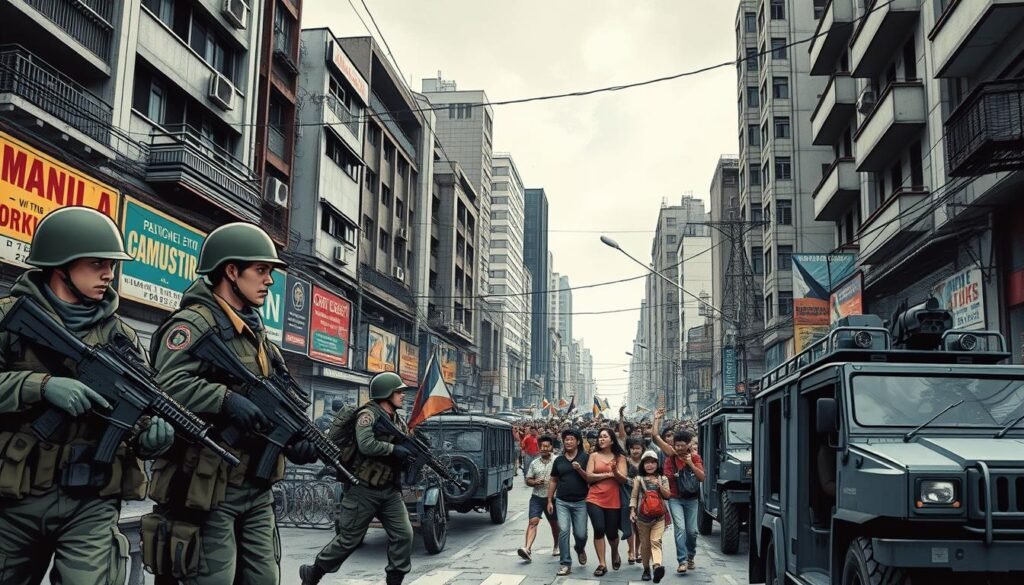
The early 1980s were chaotic in the Philippines. The Martial Law regime faced increasing opposition. The Economic Crisis and unrest helped the Opposition Movement grow.
As the 1980s progressed, the Philippines was on the brink of a major political shift.
Origins of Civil Disobedience in the Philippines
The idea of civil disobedience started in the Philippines during its fight for freedom. This fight was against Spanish and American rule. Key figures helped shape this movement, making it a major strategy for the opposition in the 1980s. Civil disobedience was crucial in the country’s quest for freedom and democracy.
In Philippine history, non-violent resistance was often used to protest. Ninoy Aquino believed that violence and revolution cost too much in lives and values. The opposition took part in the 1978 Batasang Pambansa elections, losing but gaining experience. This experience was the start of the Philippine History of civil disobedience, leading to the end of the Marcos regime.
Some key events in the Philippines’ civil disobedience history include:
- The 1986 EDSA People Power Revolution, lasting four days with millions of Filipinos involved.
- The declaration of Martial Law for nine years, from 1972 to 1981.
- The snap elections on February 7, 1986, marred by vote-buying and tampering.
The Civil Disobedience movement in the Philippines has a rich Philippine History. Key figures and events have shaped it. Knowing its origins helps us understand the country’s fight for freedom and democracy.
The Assassination of Benigno Aquino Jr.
The event that would change the course of Philippine history was the assassination of Benigno Aquino Jr. on August 21, 1983. This pivotal moment galvanized the opposition movement. It led to widespread protests and demonstrations across the country. As the chief opposition leader during the martial law period, Aquino’s death sparked outrage and calls for justice.
Aquino’s return to the Philippines after three years in exile was met with both excitement and trepidation. His assassination at Manila International Airport, immediately after disembarking from an airplane, sent shockwaves throughout the nation. The subsequent investigation and trial revealed a complex web of events. An independent commission concluded that a military conspiracy was responsible for the assassination.
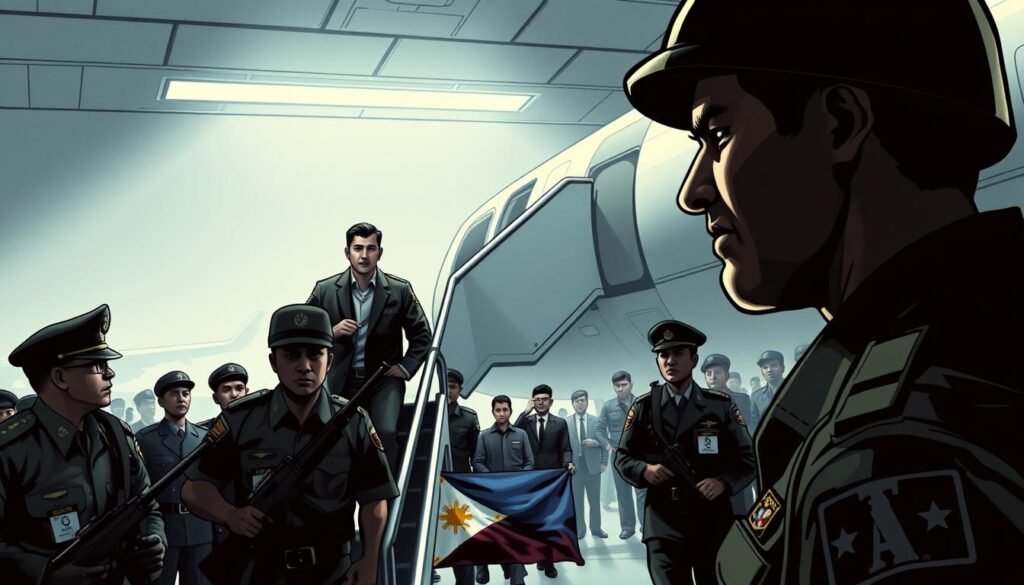
The impact of Aquino’s assassination on Philippine society was profound. It led to a surge in anti-Marcos sentiment. Many Filipinos demanded justice and an end to the authoritarian rule. The international community also responded, with many countries condemning the assassination and calling for reforms.
Key facts about the assassination include:
- Aquino was 50 years old at the time of his death
- He spent eight years in prison before his exile
- The assassination occurred at approximately 13:00 PST (UTC+08:00) on August 21, 1983
- At least 17 shots were fired during the assassination
- Over 1,000 armed soldiers and police were assigned to secure the airport during Aquino’s arrival
The aftermath of the assassination saw Corazon Aquino, Benigno’s widow, rise to power as a result of the public outcry. Her leadership played a significant role in the eventual downfall of the Marcos regime in 1986. The legacy of Benigno Aquino Jr. continues to be felt in the Philippines, with his son, Benigno S. Aquino III, serving as president from 2010 to 2016.
Understanding the People Power Movement
The People Power Movement was a complex event in the Philippines. It was a result of years of opposition against the Marcos regime. This regime was known for corruption, human rights abuses, and economic troubles.
The movement used peaceful protests and rallies. These actions led to the ousting of President Ferdinand Marcos in 1986.
This event was a big change in Philippine History. It showed the power of the people demanding change and fighting for their rights. Key figures like Corazon Aquino led the movement. She became the president of the Philippines after Marcos left.
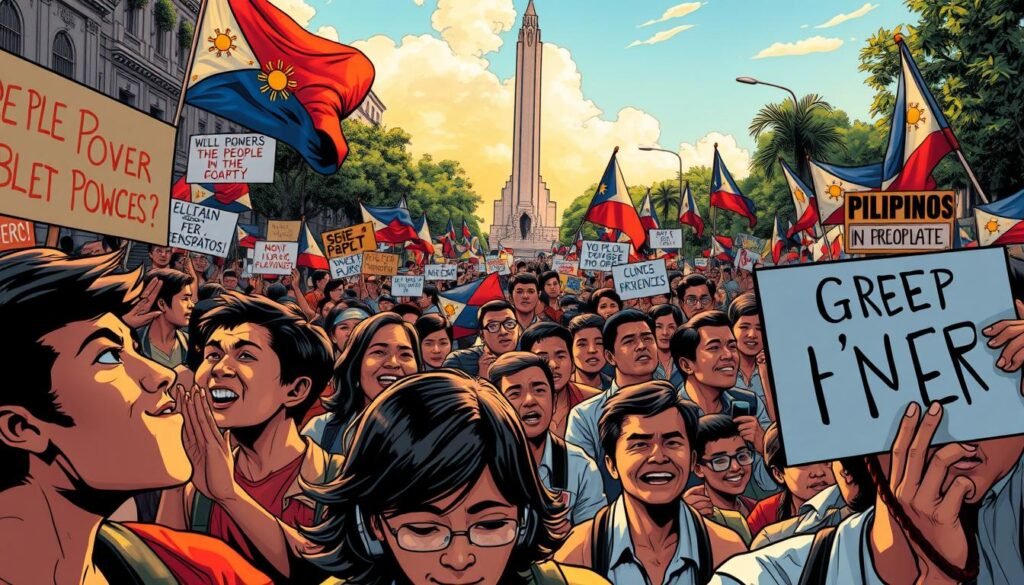
Some key events helped the People Power Movement succeed. These include:
- The assassination of Benigno Aquino Jr. in 1983, which sparked the opposition
- The formation of the National Movement for Free Elections (NAMFREL), which exposed election fraud in 1984
- The protests and rallies before the 1986 presidential election, which drew hundreds of thousands
The People Power Movement has left a lasting mark on Philippine History. It shows the power of non-violent resistance and democratic change. Its legacy inspires people worldwide and is celebrated in the Philippines today.
Key Figures and Organizations
The People Power Movement had key figures and groups that were crucial. Corazon Aquino, the widow of Benigno Aquino Jr., became a leader. Cardinal Sin gave spiritual support. The Military Reformers, who defected from Marcos, also helped a lot.
Together, they worked for change in the Philippines. Corazon Aquino and Cardinal Sin rallied the opposition. The Military Reformers boosted the movement’s drive.
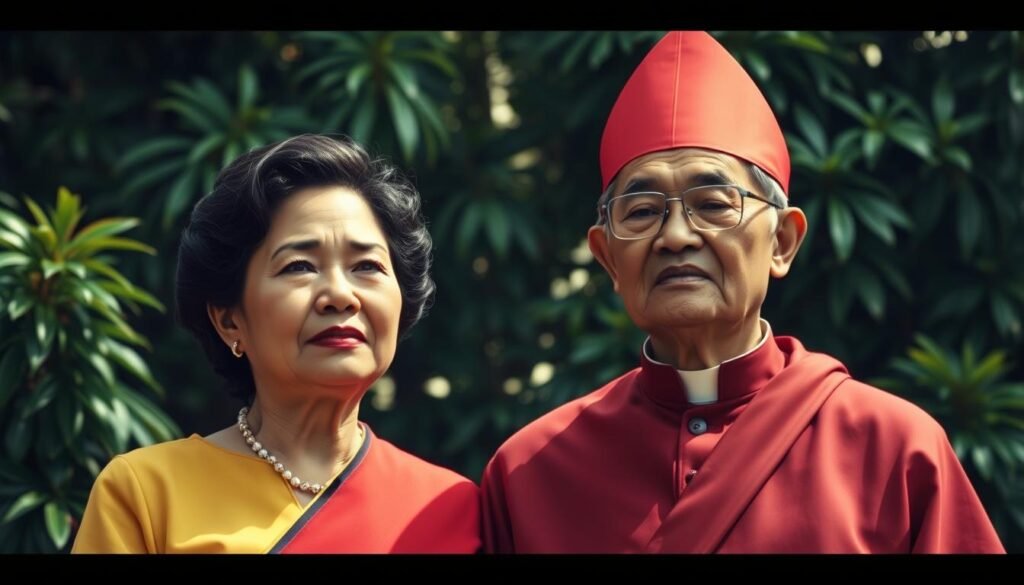
Their work led to Marcos’s fall and a new democracy. Corazon Aquino, Cardinal Sin, and the Military Reformers showed the power of people’s change.
Leadership and Guidance
Corazon Aquino and Cardinal Sin shaped the movement. The Military Reformers gave military support for success.
Role of the Military Reformers
The Military Reformers, led by Fidel Ramos and Juan Ponce Enrile, were key. Their switch from Marcos was a big moment for democracy.
The EDSA Revolution Unfolds
The EDSA Revolution was a key moment in Philippine history. It was a fight for democracy. From February 22 to 25, 1986, thousands of Filipinos took to the streets in Metro Manila. They wanted President Ferdinand Marcos out.
The People Power Movement was growing strong. Groups like the opposition, church, and military helped make the revolution a success.
The Marcos regime had faced years of resistance. It was known for corruption, abuse of power, and human rights issues. The EDSA Revolution was peaceful and non-violent. People from all walks of life joined to demand change.
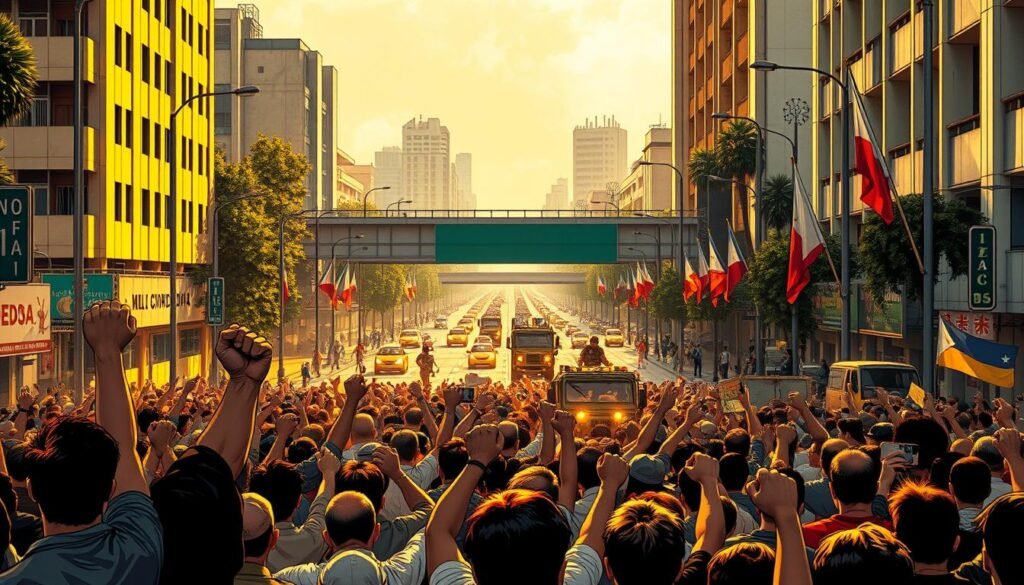
Important moments included military leaders switching sides and a new government forming. Marcos eventually left the country. The People Power Movement showed its strength. The EDSA Revolution led to democracy’s return in the Philippines. Corazon Aquino became the new president on February 25, 1986.
Role of the Catholic Church
The Catholic Church was key in the People Power Movement. It offered religious leadership and backed peaceful resistance. This support was crucial in the fight against the Marcos regime. With over 85 million Catholics, the church’s influence was huge in shaping the country’s politics.
Leaders like Cardinal Sin were vital in pushing for peaceful resistance. They urged Filipinos to oppose the Marcos regime. The Catholic Bishops’ Conference of the Philippines (CBCP) also spoke out against human rights violations and called for fair elections. Their actions helped unite the opposition and led to Marcos’s fall.
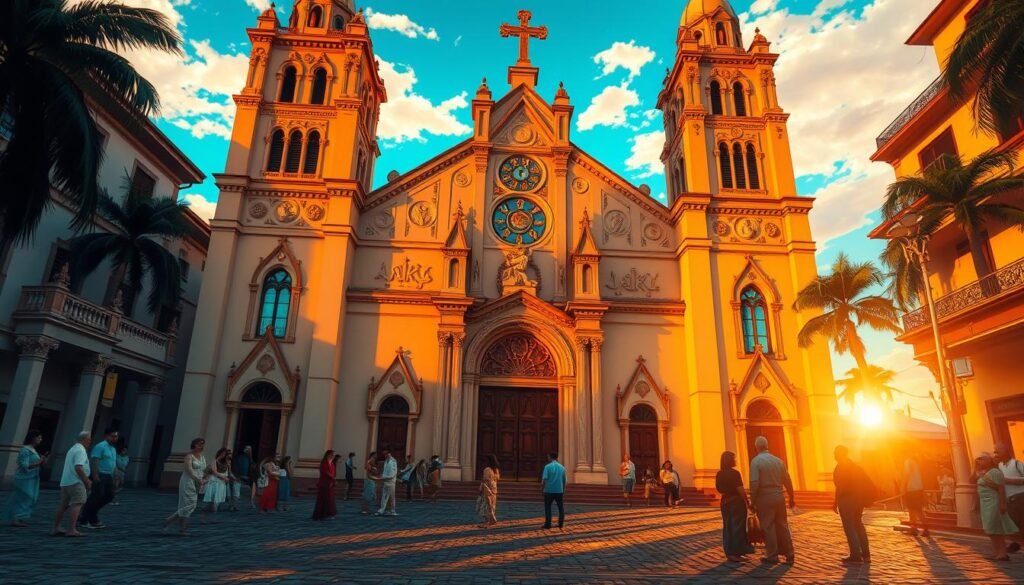
The church did more than just lead with religious leadership. It also championed peaceful resistance. This encouraged Filipinos to join peaceful protests. The church’s message of peace and justice united people across different backgrounds.
Some important facts about the Catholic Church’s role include:
- The church’s leaders, like Cardinal Sin, were crucial in promoting peaceful resistance.
- The CBCP condemned human rights abuses and pushed for fair elections.
- The church’s efforts helped unite the opposition and led to Marcos’s downfall.
International Media Coverage and Global Support
The People Power Movement in the Philippines got a lot of International Media attention. This attention was key in uniting the opposition and pushing the Marcos regime. It helped spread the movement’s message and got Global Support from abroad.
Studies show that the movement’s success was boosted by International Media coverage. The movement’s call for democracy and freedom touched hearts worldwide. This led to a lot of Global Support.
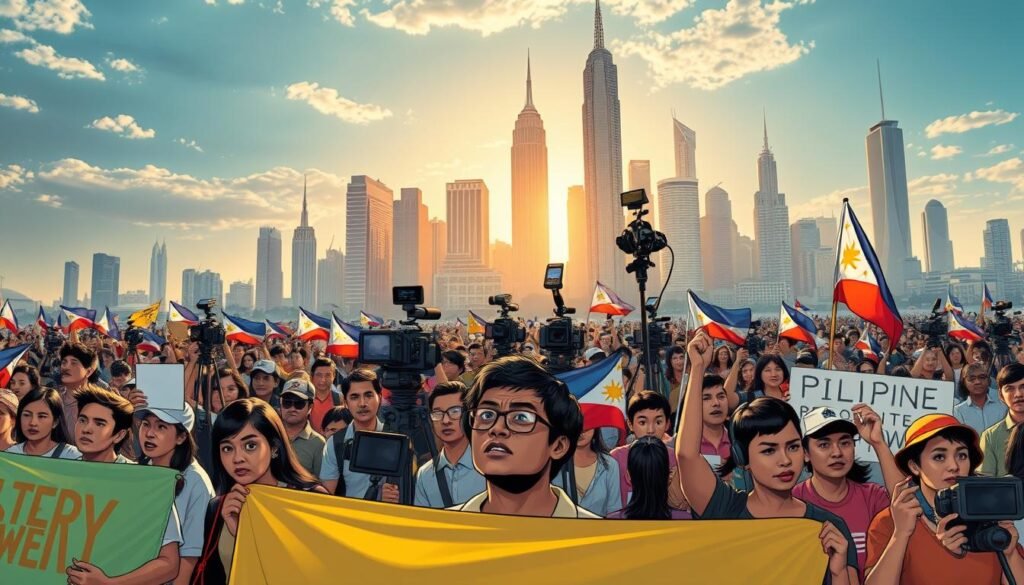
The role of International Media in the movement’s victory is huge. It added urgency and momentum, forcing Marcos to step down. The Global Support the movement got also shaped the country’s future. It helped create a more democratic and free society.
Military Defections and Strategic Shifts
The role of military defections in civil resistance movements is key. Military Defections can help or hinder the move to democracy. It depends on whether the defections are united or split.
In the People Power Movement, the RAM Movement was crucial. The Chain of Command breakdown was a major factor in the regime’s fall. Studies show that about 7% of autocratic leaders fell between 1950 and 2012 due to nonviolent protests. This shows how important Military Defections are in these movements.
Some important facts about military defections are:
- 33% of fallen autocrats were overthrown by military or insider coups.
- 51% of all mass-protest campaigns were studied, with 40 cases.
- 12 of 14 loyalty shifts led to democracy within three years.
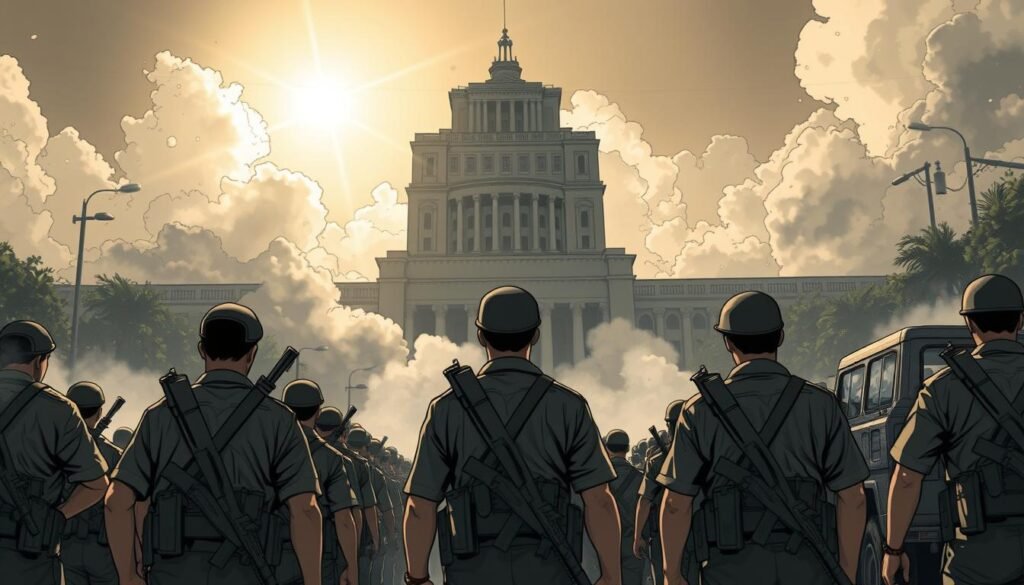
These numbers show how big of a deal Military Defections and strategic shifts are. They help shape the outcome of civil resistance movements. Knowing these complexities helps activists and scholars in the transition to democracy.
The Fall of the Marcos Regime
The Marcos Regime ended on February 25, 1986. Ferdinand Marcos and his family left the country. This was after 20 years of rule.
Years of opposition and protests led to this moment. The economic crisis and social unrest made the regime unsustainable.
The days before Marcos left were filled with protests. Corazon Aquino led the opposition, gaining more support. The world was watching, and the Marcos Regime faced growing criticism.
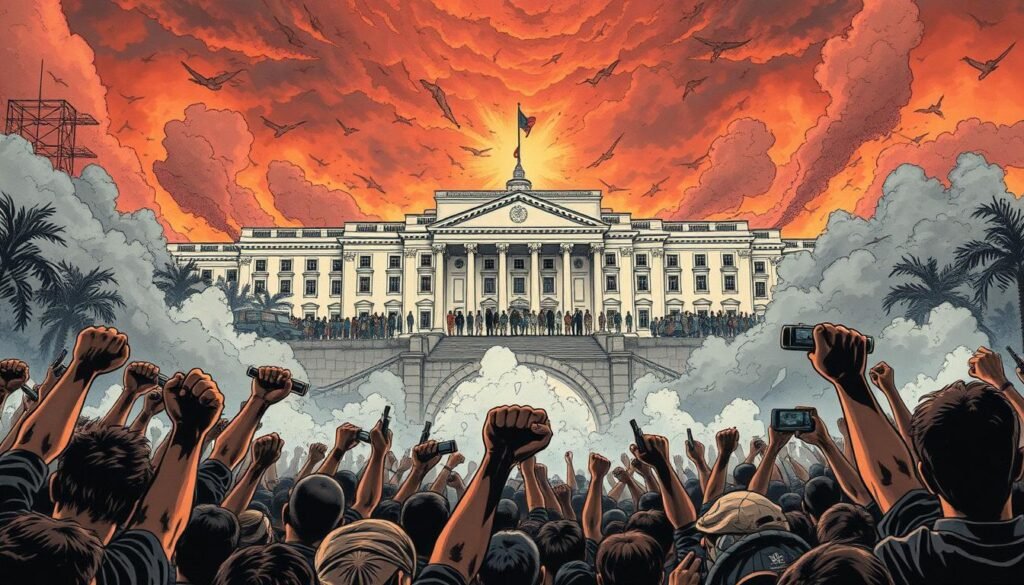 This event was a major shift in Philippine history. It moved the country from dictatorship to democracy.
This event was a major shift in Philippine history. It moved the country from dictatorship to democracy.
Several factors led to Marcos’ downfall:
- Widespread corruption and human rights abuses
- Economic crisis and social unrest
- International pressure and criticism
- Growing opposition and protests
The end of the Marcos Regime was a key moment in Philippine history. It marked the start of a new era of democracy and freedom.
Transition to Democracy
The Philippines’ transition to democracy was a big step in its history. This time, a New Government was formed. Also, Constitutional Reforms were put in place to stop authoritarian rule from coming back.
This change to democracy was a complex journey. It needed the effort of many people and careful planning. Some important parts of this journey include:
- Creating a new constitution
- Setting up a new government
- Starting constitutional reforms
Formation of New Government
After the EDSA Revolution, a new government was formed. This ended the Marcos regime. The new government had to make sure the Constitutional Reforms worked well. They also had to help the country smoothly move to democracy.
Constitutional Reforms
The Constitutional Reforms were made to stop power from being too concentrated. They made sure the government was answerable to the people. These changes helped the country move to a democratic system. A New Government was set up, dedicated to democracy and human rights.
Social and Economic Aftermath
The Social and Economic Aftermath of the People Power Movement had a big impact on the Philippine Economy. The country faced many challenges, like poverty, inequality, and corruption. These issues kept affecting the nation for years.
The Philippine Economy had a hard time bouncing back after the movement. Many Filipinos were still struggling financially. Corruption and inequality were big problems, making it hard for the country to grow economically.
Some major issues that hit the Philippine Economy included:
- Poverty and income inequality
- Corruption and lack of transparency
- Unemployment and underemployment
The aftermath of the People Power Movement shows how crucial it is to tackle inequality. By understanding these challenges, we can aim for a fairer and more stable future for all Filipinos.
Global Impact and Historical Significance
The People Power Movement had a huge Global Impact. It influenced democratic transitions all over the world. This movement’s Historical Significance comes from inspiring other social movements. It showed the strength of peaceful resistance and citizen involvement.
Its global influence came from being non-violent. Figures like Corazon Aquino played a big role. The movement’s effect on Democratic Transitions is clear. It showed that peaceful change is possible.
The People Power Movement’s legacy still affects us today. It focused on citizen participation and democratic values. Its lasting influence is seen in its role in democratic movements. It highlights the power of peaceful resistance and Historical Significance in shaping political history.
Modern Legacy in Philippine Politics
The People Power Movement has left a lasting Modern Legacy in Philippine Politics. Its impact is still seen in today’s political debates and struggles. The movement’s ideals and strategies continue to influence Philippine politics and society.
They shape how people interact with the government and push for change.
Some key aspects of the movement’s legacy include:
- Increased political awareness and participation among citizens
- A stronger emphasis on human rights and social justice
- A more active and engaged civil society
The Modern Legacy of the People Power Movement shows the power of collective action. It highlights the importance of protecting democratic institutions. As the Philippines deals with the challenges of Philippine Politics, the movement’s legacy reminds us of the need for ongoing vigilance and engagement.
Commemorations and Cultural Impact
The People Power Movement is celebrated every year in the Philippines. Many events happen to honor its legacy. The People Power Revolution has greatly impacted the country. It has inspired national pride and unity.
The EDSA Shrine is a key symbol of this movement. It reminds us of the strength of peaceful protests and the value of democracy.
Commemorations include parades, rallies, and more. These events unite people from all backgrounds. The EDSA Shrine is a central part of these celebrations. Many Filipinos visit to honor the movement’s significance.
- Annual parades and rallies
- Visits to the EDSA Shrine
- Reflections on the movement’s legacy
These events remind us of the power of coming together. They highlight the need to protect democracy. The People Power Movement’s impact still inspires Filipinos today. It encourages them to get involved in civic activities.
Conclusion: The Enduring Spirit of People Power
The People Power Movement has inspired change around the world. The People Power Revolution was a key moment in the Philippines. It showed how people can come together and make a difference without violence.
This movement’s spirit still shapes today’s politics. For example, the Second EDSA Revolution led to President Joseph Estrada’s resignation in 2001. It showed that peaceful action can lead to big changes.
Important figures like Gloria Macapagal Arroyo and Estrada have been influenced by this movement. It teaches us about the power of standing together and choosing peaceful ways to fight for change. The Philippines keeps moving forward, and the People Power spirit remains a beacon of hope for democracy and freedom.
FAQ
What was the People Power Movement in the Philippines?
The People Power Movement, also known as the EDSA Revolution, was a series of protests in 1986. It led to the fall of President Ferdinand Marcos and the return of democracy in the Philippines.
Who was Benigno Aquino Jr. and what was his role in the People Power Movement?
Benigno Aquino Jr. was a Filipino senator and opposition leader. He was assassinated in 1983, sparking outrage and protests against Marcos. This helped the People Power Movement succeed.
What was the significance of the EDSA Revolution in Philippine history?
The EDSA Revolution was a key moment in Philippine history. It ended Marcos’ authoritarian rule and started the country’s move towards democracy. Corazon Aquino became the first female president of the Philippines.
How did the Catholic Church contribute to the success of the People Power Movement?
The Catholic Church was crucial in the People Power Movement. Cardinal Jaime Sin led religious efforts for peaceful resistance. This support helped the movement gain public backing and succeed.
What was the international response to the People Power Movement?
The international community supported the People Power Movement. Foreign governments and media condemned Marcos’ human rights abuses. They called for democratic reforms in the Philippines.
What were the key factors that led to the success of the People Power Movement?
The People Power Movement’s success came from several factors. Corazon Aquino’s leadership, the Catholic Church’s support, military defections, and public discontent with Marcos were key. These factors led to the regime’s downfall.
What was the impact of the People Power Movement on Philippine society and economy?
The People Power Movement had a big impact on the Philippines. It led to a new democratic government and economic reforms. It also promoted social justice and human rights. However, the country still faces challenges like poverty and corruption.
What is the legacy of the People Power Movement in contemporary Philippine politics?
The People Power Movement’s legacy is strong in Philippine politics today. It emphasizes democracy, human rights, and peaceful resistance. Its influence is seen in the country’s ongoing fight for social justice and good governance.
How is the People Power Movement commemorated in the Philippines?
The People Power Movement is remembered in the Philippines through various events. The annual EDSA Revolution Anniversary is celebrated on February 25. There is also the EDSA Shrine, a monument to the revolution’s heroes.
What is the global significance of the People Power Movement?
The People Power Movement has global importance. It has inspired democratic movements and transitions worldwide. It shows the power of nonviolent resistance and collective action in achieving social change and promoting human rights and democracy.
Source Links
- EDSA PEOPLE POWER REVOLUTION – Amnesty Philippines
- The Legacy of the EDSA People Power Revolution
- People Power in the Philippines
- The People Power Revolution, Philippines 1986
- History of the Philippines | People, Spain, United States, Revolution, Map, & Facts | Britannica
- Political history of the Philippines
- Never forget EDSA & People Power
- Looking back at the 1986 EDSA People Power Revolution | Carlos Hilado Memorial State University
- Benigno Aquino, Jr. | Philippine President, Political Activist & Martyr | Britannica
- Assassination of Ninoy Aquino
- Filipinos campaign to overthrow dictator (People Power), 1983-1986
- In 1986, the Philippines’ People Power was world’s bright spot
- People Power and the Philippines after 25 years
- Timeline of the People Power Revolution
- Key players in the 1986 People Power Revolution
- EDSA People Power Revolution: What Are the Events that Unfolded in Cebu
- Poe: People’s sacrifices for democracy must be remembered
- The Constitution of the Philippines and transformative constitutionalism | Global Constitutionalism | Cambridge Core
- Philippine bishops urge people not to forget ‘dark years’ of dictatorship – Vatican News
- The Catholic Church’s place was at EDSA in 1986, where should it be now?
- Catholic nation? The Filipino Church rethinks its role in politics.
- Leni Robredo: The woman leading the Philippines’ ‘pink revolution’
- Media Freedom: A Downward Spiral
- Globally, Broad Support for Representative and Direct Democracy
- Project MUSE – Mass Protests and the Military
- Defection and revolution in Myanmar – New Mandala
- Dismantling the Junta from Within
- Philippines – Martial Law, Marcos, Dictatorship | Britannica
- Managing the End of the Marcos Regime – Association for Diplomatic Studies & Training
- People Power Fatigue: How Past Revolutions’ Rise (And Fall) Led to Democratic Erosion in the Philippines – Democratic Erosion
- Philippine ‘People Power’ Thirty Years On
- A Marcos returns to power in the Philippines
- EDSA People Power Revolution
- Project MUSE – Organizing "People Power" in the Philippines
- Five things to know about Martial Law in the Philippines
- A member of the Marcos family is returning to power — here’s what it means for democracy in the Philippines
- People Power Revolution
- People Power at 25: Long road to Philippine democracy
- Remembering ‘People Power’ in ASEAN
- Ousting Erap: The Second People Power Revolution | Sinaunangpanahon
- Answers to: Write an essay about Edsa people power revolution

